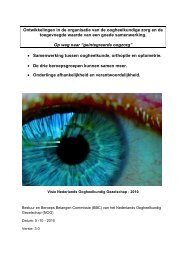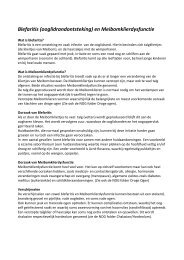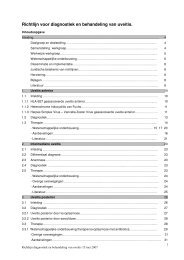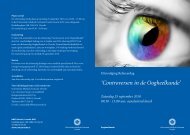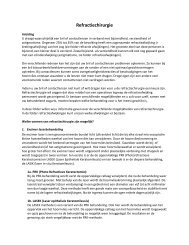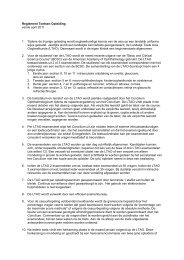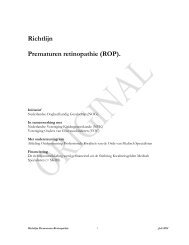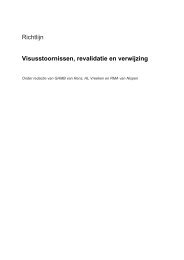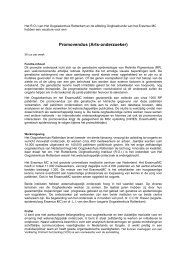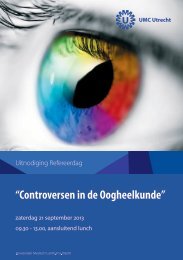terminology and guidelines for glaucoma ii - Kwaliteitskoepel
terminology and guidelines for glaucoma ii - Kwaliteitskoepel
terminology and guidelines for glaucoma ii - Kwaliteitskoepel
You also want an ePaper? Increase the reach of your titles
YUMPU automatically turns print PDFs into web optimized ePapers that Google loves.
The optic disc rim may show atrophy with an afferent pupillary defect<br />
Symptoms:<br />
Mild, intermittent symptoms of acute angle-closure type<br />
2.4.1.3 - Chronic Angle-Closure Glaucoma (CACG)<br />
Etiology: permanent synechial closure of any extent of the chamber angle as confirmed by indentation gonioscopy.<br />
Pathomechanism: see Ch. 2.4.1<br />
Features:<br />
Signs:<br />
Peripheral anterior synechiae of any degree at gonioscopy<br />
IOP elevated to a variable degree depending on the extent of angle-closure, above 21 mm Hg<br />
Visual acuity according to functional status (may be normal)<br />
Damage of optic nerve head compatible with <strong>glaucoma</strong><br />
Visual field defects “typical” of chronic <strong>glaucoma</strong> may be present<br />
Superimposed intermittent or acute angle-closure possible<br />
Symptoms:<br />
Visual disturbances according to functional states<br />
Usually no pain; sometimes discom<strong>for</strong>t<br />
Transient “haloes” when intermittent closure of the total circumference causes acute IOP elevations<br />
2.4.2 - STATUS POST ACUTE ANGLE-CLOSURE ATTACK<br />
Etiology: previous episode of acute angle-closure attack<br />
Pathomechanism: see Ch. 2.4.1<br />
Features:<br />
Signs:<br />
Patchy iris atrophy<br />
Iris torsion/spiralling<br />
Posterior synechiae<br />
Pupil either poorly reactive or non reactive<br />
“Glaukomflecken” of the anterior lens surface<br />
Peripheral anterior synechiae on gonioscopy<br />
Endothelial cell count can be decreased<br />
2.4.3 - THE “OCCLUDABLE” ANGLE; ACR (Angle-Closure Risk)<br />
Etiology: pupillary block, plateau iris or lens; each component plays different roles in different eyes<br />
Pathomechanism: see Ch. 2.4.1<br />
Features:<br />
Signs:<br />
Iridotrabecular apposition <strong>and</strong>/or PAS<br />
IOP elevation may be present<br />
Fellow eye of acute angle-closure attack<br />
Fellow eye of documented non-secondary angle-closure<br />
Ch. 2 - 16 EGS



